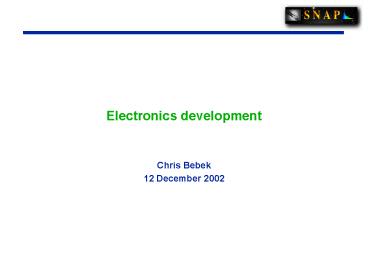Electronics development - PowerPoint PPT Presentation
1 / 17
Title:
Electronics development
Description:
Employ existing, tested solutions with space flight heritage wherever possible. ... yes. FPGAs. 7. Custom ICs R&D Goals ... Dear SPENVIS user, ... – PowerPoint PPT presentation
Number of Views:108
Avg rating:3.0/5.0
Title: Electronics development
1
Electronics development
- Chris Bebek
- 12 December 2002
2
(No Transcript)
3
Strategy for Instrument Electronics
- Employ existing, tested solutions with space
flight heritage wherever possible. - Avoid single-point failures and maintain
redundancy where possible within power, weight,
cost budgets. - Keep number of components and interconnections to
a minimum for reliability. - Reduce number and length of cables carrying
low-level analog signals to avoid noise pickup,
crosstalk. - Use a common architecture for readout of
different sensors to extent possible, to reduce
number of different electronics systems. - Have a fallback option for areas of technical or
schedule risk.
4
Electronics RD Overview
- Readout electronics development activity
- Develop and test CCD front-end electronics
- HgCdTe front-end being developed by Rockwell -
procure test - Spectrograph goal to utilize same CCD and
HgCdTe readout. - Judicious use of ASICs where most benefit is
derived. - Build small proof-of-principle system prototype.
- DAQ study and tradeoff activities
- Compress, buffer and transmit all exposures.
- Look for existing solutions explore full custom
- Develop essential model and conceptual design.
- Instrument Controls study and tradeoff
activities - Configure onboard device parameters modes,
voltage levels, etc. - Instruments need to be cycled, voltages
monitored, etc. - Develop essential model and conceptual design
5
(No Transcript)
6
?
yes
ASICs
?
?
FPGAs
7
Custom ICs RD Goals
- The RD goals are to provide thorough and
complete answers in the following areas - Readout noiseNoise optimization and signal
processing study - Power optimizationIn general, low power is
required for space, and very low power is
mandatory if we want to locate the front end
electronics close to the CCDs. Its power
consumption should be a small fraction of the CCD
power. - Operation at cold temperatureEvaluate current
technology performances at cold temperature
(140K) and verify/modify the model for a reliable
design. - Radiation hardness Evaluate current technology
performances in radiation environment especially
at low temperature - PrototypeDesign and test a reliable prototype
before construction
8
Channel architecture
Control logic
CDS
Output buffers
Single to differential stage
Multi range integrator
9
Data volume
- CCD
- 16b x 444 Mpix gt 7.1 Gb / image
- HgCdTe
- 16b x 151 Mpix x 8 reads gt4.8 Gb / image
(Reduced x2 with 4-read averages) - Spectrograph
- 16b x 0.5 Mpix gt 8.4 Mb/image (dominated by
HgCdTe) - Read image every 5.5 s (worst case assumption)
- Assumptions
- 62 hrs/orbit alive 60/40 photo/spectro split
- 300/1000(max) s photo/spectro exposure time
- photometry active during spectroscopy time
- SSR w/ 21 compression
- Orbit data
- Imager during photometry 62 hrs x 60 / 300 s x
6 Gb gt 2.7 Tb - Imager during spectroscopy 62 hrs x 40 / 1000
s x 6 Gb gt 0.5 Tb - Spectrograph 62 hrs x 40 / 5.5 s 8.4 Mb gt
0.14 Tb - TOTAL 3.9 Tb / orbit
10
Compression
Consultative Committee for Space Data Systems
(CCSDS)
CCSDS 121.0-B-1. Lossless Data Compression. Blue
Book. Issue 1. May 1997. This Recommendation
defines a source-coding data-compression
algorithm and specifies how data compressed using
the algorithm are inserted into source packets
for retrieval and decoding. ISO Number 15887
Rice algorithm is recommended. Compression is
local telemetry errors do not
propagate Software exists C, VHDL, Some
hardware exists not 14-16 bit insufficient
throughout. Distributed, on-the-fly FPGA
implementation being explored.
11
Radiation shielding
- Chris Bebek
- 12 December 2002
12
The shield
We know have to cover our rear, also.
13
Proton flux
14
Shielded proton flux
Note transition to increased flux.
15
Other stuff
16
Exploit HEP experience
CERN RD44 CERN, ESA, GEANT 4
XMM and Chandra projects have used Geant for
shielding studies.
17
Mainstreamed?
- Dear SPENVIS user,
- The Multi-Layered Shielding Simulation (Mulassis)
tool has been implemented in the SPENVIS
radiation analysis package. Mulassis is a
computer code developed by Qinetiq
(http//www.qinetiq.com) to assess radiation
shielding performance for simple shield
geometries (multi-layered planar or spherical
shields). The code uses the GEANT4
(http//geant4.web.cern.ch/geant4/) radiation
transport toolkit as the basis of the simulation
to treat the run-management, geometry tracking,
and physical interaction processes.

